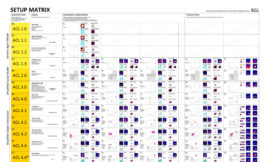Wasserman, Stanley
Resumed
1.4 Distinctive Features of Network Theory and Measurement the use of structural or relational information to study or test theories. translate core concepts in social and behavioural theories into formal definitions expressed in relational terms require measurements on ties among social units (or actors); however, attributes of the actors may also be collected. cannot use multiple regression, t tests, canonical correlations, structural equation models, and so forth, to study social network data or to test network theories. A social network analysis must consider data on ties among the units. However, attributes of the actors may also be included. Measurements on actors will be referred to as network composition. Complex network data sets may contain information about the characteristics of the actors (such as the gender of people in a group, or the GNP of nations in the world), as well as structural variables. one has not only structural, but also compositional, variables propositions about group relational structure: Social network theories require specification in terms of patterns of relations, characterising a group or social system as a whole. Given appropriate network measurements, how the system behaves, and statistical methods to test the appropriateness of the propositions. units at different levels of aggregation: individual actors, dyads, triads, subgroups, and groups. theoretical statements and hence measurements at more than a single level. 1.5 Organization of the Book and How to Read It themes in network analysis: The complexity of the methods Descriptive versus statistical methods The theoretical motivation for the methods The chronological development of the methods The level of analysis to which the methods are appropriate
2 Social Network Data: Collection and Applications
network data include measurements on the relationships between social entities
2.1 Introduction: What Are Network Data?
Social network data consist of at least one structural variable measured on a set of actors
the nature of the study determines whether the entire set of actors can be surveyed or whether a sample of the actors must be taken.
Thus, it is crucial to understand the nature of these variables. The data collection techniques described here determine, to some degree, the characteristics of the relations.
2.1.1 Structural and Composition Variables
two types of variables:
structural and composition.
Structural variables measure ties of a specific kind between pairs of actors.
Composition variables, or actor attribute variables, are of the standard social and behavioral science variety, and are defined at the level of individual actors.
i.e. gender, race, or ethnicity for people, or geographical location, after-tax profits, or number of employees for corporations.
2.1.2 Modes
“mode” to refer to a distinct set of entities on which the structural variables are measured.
The most common type of network is a one-mode network, since all actors come from one set.
A two-mode network data set contains measurements on which actors from one of the sets have ties to actors in the other set. Usually, not all actors can initiate ties. Actors in one of the sets are “senders,” while those in the other are “receivers”
higher-mode: three or more data sets
2.1.3 Affiliation Variables
Affiliation networks are two-mode, but have only one set of actors. The second mode in an affiliation network is a set of events
in affiliation network data the two modes are the actors and the events. the events are efined not on pairs of actors, but on subsets of actors.
attendance or interactions among people provide the affiliations of the actors
2.2 Boundary Specification and Sampling
identify the population to be studied
sample actors and relations.
2.2.1 What Is Your Population?
who are the relevant actors? Which actors are in the population?
The boundary of a set of actors allows a researcher to describe and identify the population under study.
a clear “external” definition of the boundary
define actor set boundaries based on the relative frequency of interaction, or intensity of ties among members as contrasted with non-members.
realist approach, focuses on actor set boundaries and membership as perceived by the actors themselves.
nominalist approach, is based on the theoretical concerns of the researcher.
ex:
- Coleman, Katz, and Menzel (1957):
It was decided to include in the sample, as nearly as possible, all the local doctors in whose specialities the new drug was of major potential significance. This assured that the “others” named by each doctor in answer to the sociometric questions were included in the sample. - Laumann and Pappi (1973):
… name all persons [who] are now in general very influential in Altneustadt.
all methods must be applied to a specific set of data which assumes not only finite actor set size(s), but also enumerable set(s) of actors.
the set of actors consists of all social units on which we have measurements (either structural variables, or structural and compositional variables).
Many network studies focus on small collectivities, such as classrooms, offices, social clubs, villages, and even, occasionally, artificially created and manipulated laboratory groups.


